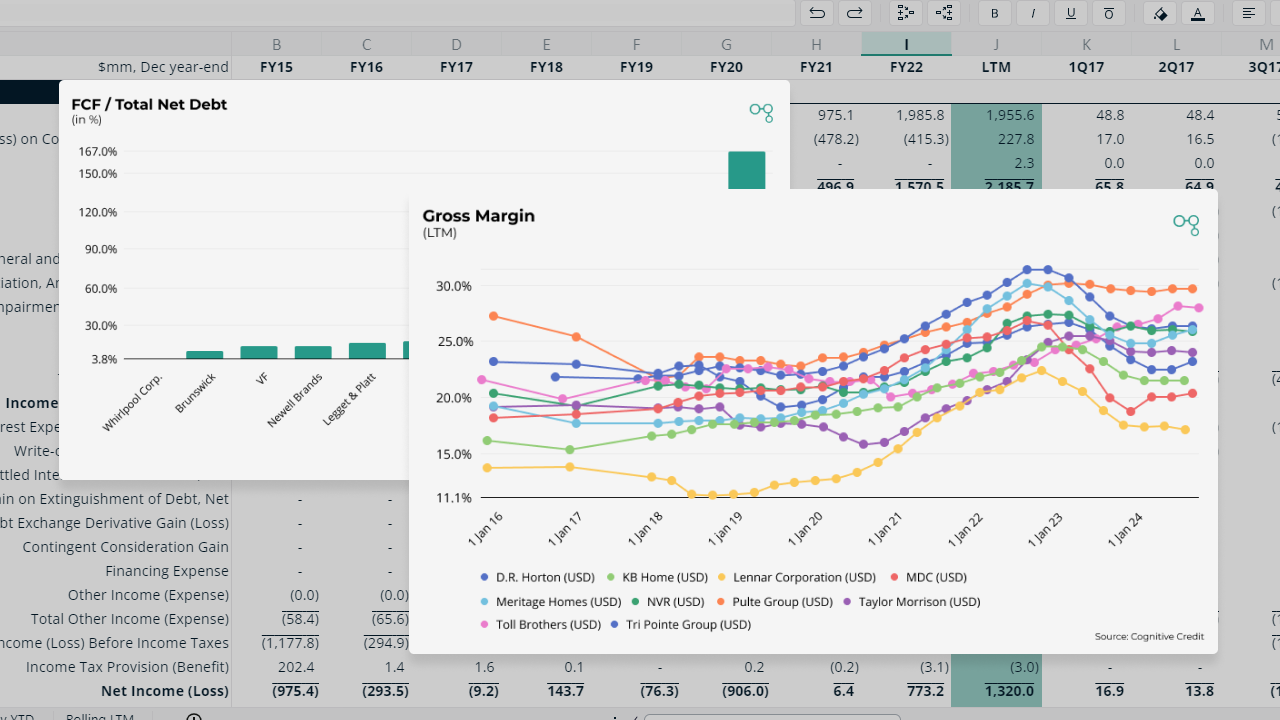Our analysts take a look at the data from the 2Q24 earnings cycle and identify more interesting observations across US markets and sectors.
As each quarterly earnings cycle ends, we take some time to analyze the enormous amount of data we process with our Comparables feature - a powerful tool to view markets and sectors top down and in their entirety - to see what sector trends jump out at us across our current coverage universes.
Without further delay, here's our Quarterly Earnings Breakdown for 2Q24 - US Edition.
Homebuilders resilient despite the high rate environment
U.S. homebuilders have been resilient in the face of high mortgage rates, with latest period revenues up 8.7% yoy and EBITDA up 8.5% yoy. The sector has benefitted from historically low inventory, as high rates serve to deter homeowners with existing low-rate mortgages from listing homes for sale. Homebuilders have also been successful in offering incentives such as mortgage rate buy-downs and closing cost credits to keep inventory moving. Profitability has remained relatively stable, with gross margins only drawing down slightly from their peak in mid 2022.



Lennar Corporation, the nation's second largest homebuilder, has seen a steady increase in total homes ordered and homes delivered over the last several quarters. The company’s in-house mortgage department has also been able to capture more customers, with mortgage origination volumes nearly doubling since 2021.



Consumers focused on experiences rather than tangible products
As inflation retracts, we have observed a shift in the mix of consumer spending, with an increased focus towards experiences and away from tangible products. While consumer services (a focus of our FY23 US Earnings Breakdown) second quarter revenue and EBITDA were up 5.7% and 10.5% year-over-year respectively, consumer durables & apparel (excluding homebuilding) revenue and EBITDA was down 6% and 20% respectively.
Of the 12 companies within consumer durables & apparel with over $1B in revenue, only two posted positive revenue growth for the period: Levi Strauss (7.8% yoy) and Crocs (3.6% yoy). These two companies also posted the strongest gross margins of the group.

Looking deeper at the balance sheet positioning of this sector, Levi and Crocs stood out again when looking at FCF/Total Net Debt. They also showed favorable net leverage and interest coverage in relation to peers. These metrics were relatively weak for Newell Brands, VF and Whirlpool Corporation.


Crowdstrike Leading the Software Industry
Capital spending in the application software industry continued to be strong, with revenues up on average 8.2% from prior year. Cybersecurity continues to be one of the fastest growing software categories as companies protect themselves from ever so common digital threats. A leader in this area, Crowdstrike revenue growth shined, up 31.7% from prior year.

The company has nearly doubled its annual recurring revenue in the last two years, while maintaining its gross margin and continuing to grow its EBITDA margin, showing sustainable profitability.


The company did experience turbulence in mid-July when a botched software update was pushed causing one of the largest IT outages in history. Although the company was hit hard in the news and markets at that time, bond spreads have normalized over the last few months (from 207 on August 5th to 113 on October 4th), showing investors saw this as a short-term issue.

AMN Health feeling the post COVID symptoms
The healthcare services industry posted positive results with revenue up 6.5% and EBITDA up 2.7% yoy. Of the 12 companies with greater than $500M in revenue, just one, AMN Healthcare, posted negative yoy revenue as well as one of the largest yoy declines in EBITDA.


Using Cognitive Credit KPI data to dig deeper, we see that Average Travelers on Assignment and Travel Nurse Staffing metrics have both declined back to pre-covid levels, as the demand for traveling nurses has pulled back. Healthcare organizations have also prioritized hiring permanent staff in order to cut costs and reduce their utilization of contingent labor. This has resulted in a major decline in top line revenue over the past several quarters for AMN Health, specifically in the company’s Nurse and Allied Solutions segment.


Analyze the entire market, faster
Cross-market analysis like the above is easy with Cognitive Credit. Our Comparables feature offers a top-down view of all our fundamental data across our four coverage universes (European & US High Yield, and European & US Investment Grade), allowing you to find relative value opportunities across your markets, sectors and companies quickly and conveniently.
To experience our web-app first-hand, sign up for complimentary access here.
